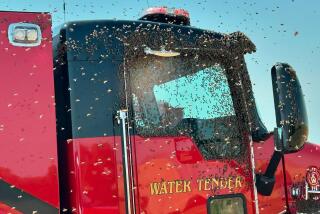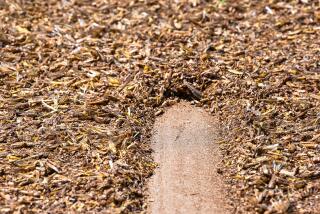A few hives short of a meltdown
IT’S like a scene out of a Stephen King novel: One sunny day, the happy buzzing sound of bees doing that spring thing that bees do fades to silence. The bees disappear, abandoning hives and leaving flowers unpollinated, never to bear fruits and vegetables. Gradually, the world starves.
That’s the picture some are painting this spring in the wake of heavier than normal losses by beekeepers. “Unless someone or something stops it soon,” one recent wire service story speculates, we could all be living on a “bread and water diet”.
But though that picture may have a certain apocalyptic appeal, it ignores some inconvenient facts.
For starters, California’s almond farmers -- who grow the most bee-intensive crop in the country -- are forecasting a record harvest this year. In fact, the latest estimate, released last week, is for this year’s crop to be almost 20% bigger than last year’s. The state’s plum, peach and nectarine farmers say that their trees are full of fruit too. And so do Washington state cherry, pear and apple farmers.
In fact, though pollination is still continuing for a few crops, so far there has been no indication that the honeybee disappearances will have any effect whatsoever on any harvest this year.
This is certainly not to suggest that there is no problem, but only to say it’s way too early to start stocking up on canned fruit.
Definitely, something very strange is going on. This winter and spring an extraordinary number of worker honeybees have been abandoning seemingly normal hives and leaving healthy queens and brood to starve. No one knows why this is happening; scientists have named it Colony Collapse Disorder.
Most agricultural pollination is done not by wild bee colonies but by commercial beekeepers who truck hives to sell their services where they are required. Since the early 1970s, the number of bee colonies in the United States has declined by almost half, due to a variety of factors including urbanization, pesticide use, pollution, various pests, and beekeepers retiring and going out of business.
The long-term dwindling of the bee population has resulted in the cost to farmers of these rented hives going up by $50 or $60 each, to $125 or more. But farmers say that rate has leveled off over the last few years.
This new problem began in November when commercial beekeepers along the East Coast began reporting sudden and drastic die-offs in their hives.
Actually, similar occurrences have been well-documented since at least the late 19th century. In the beekeeping world there is an entire lexicon of descriptors for such events, including “spring dwindle,” “fall dwindle,” “autumn collapse” and “May disease.”
“If you look back a ways, something like this happened at least as early as the 1890s,” says Eric Mussen, extension apiculturist at UC Davis, and the state’s leading bee expert.
“In the period 1963, ’64 and ‘65, we had this kind of thing happen year after year. And then again in 1975 it happened pretty hard. They called it ‘disappearing disease’ then.”
In the 1980s, infestations of a tiny bug called the Varroa mite devastated commercial hives and all but wiped out wild bee populations in the United States.
“In ‘the good old days’ beekeepers might lose 5[%] to 10% of their hives every year,” Mussen says. “Then we had the mites and that pushed us into a range of 20[%] to 25%. The hives could still handle those losses and bounce back.
“But lately, we’ve been seeing losses into the 35[%] to 40% range and even a few individuals with 75[%] to 80%. My biggest concern is that if this situation continues to go on, beekeepers might just decide it’s not worth the effort to keep up and quit the business. That would be bad.”
There are several things that make these new die-offs seem different from those in the past. In normal die-offs, the hives are filled with dead bees that can be examined to find the source of the problem; in this case, the bees simply disappeared, abandoning perfectly good hives.
The recent die-offs seem to be more rapid than those in the past and are occurring in greater numbers. They are more widespread, so far occurring in 27 states, including California. The phenomenon has been reported in Europe, though it is not clear whether these cases are truly related.
Scientists don’t know what causes Colony Collapse Disorder, and many doubt whether there is a single cause. They call it a “syndrome” rather than a “disease” because of the suspicion that it may be the result of several factors coming together.
“There is a big long list of things that can happen to honeybees that are very negative,” Mussen says.
“When they begin to add up, it’s very easy to push the population over the edge.”
The only thing that all of the problem hives seem to have in common is that they were experiencing periods of “extraordinary stress” due to poor nutrition or drought.
If the hives are already weakened, factors that otherwise might not be fatal could have disastrous effects.
“I think probably some of it had to do with local weather conditions late summer and fall last year,” Mussen says. “Because of the weather there were lots of problems with bee nutrition so I think they just got off to a rough start.”
Research seems to be focusing on two factors that might have proved the breaking point. The first, which was identified recently by researchers at the University of San Francisco, is a fungus called Nosema ceranae, evidence of which has turned up in several of the affected hives.
Bee scientists are also looking into the effects of a new class of pesticides called neonicotinoids, particularly one called imidacloprid. It is a systemic pesticide, so even if it is applied only to the soil or the seed, it can still show up in pollen collected by bees.
The use of imidacloprid has been restricted in France because of its harmful effects on honeybees, though there is disagreement among scientists both in Europe and elsewhere about whether there was enough evidence to warrant the restriction.
“You know, it’s tough to be a honeybee, that’s not news at all,” says Tim Smith, a tree fruit specialist at Washington State University.
“But I don’t think there’s any sudden alarm among users of honeybees, though of course we are all concerned about the possible long-term impact.”
*
More to Read
Sign up for Essential California
The most important California stories and recommendations in your inbox every morning.
You may occasionally receive promotional content from the Los Angeles Times.










